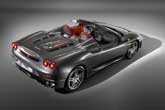Recent Articles
Popular Makes
Body Types
2006 Ferrari F430 Spider Quick Spin
Box seats for the Maranello Symphony
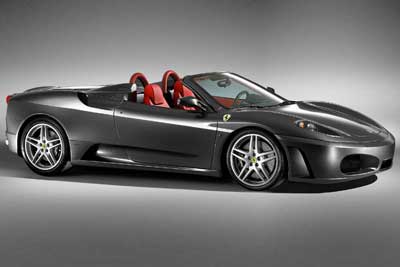
Sleek and elegant Ferrari automobiles bring out deep rooted emotions in just about every enthusiast, and the beautiful red F430 Spider to which I held the keys brought every hair on my body to attention like a platoon of fresh Army recruits. Before me, under the F430’s clear glass engine cover, sat an artist’s vision of a V8 engine, complete with nearly 500 horsepower beckoning to me. All around the Meadowood Resort’s parking lot, the high-pitched scream of more than sixty Ferrari engines mesmerized me as their owners coaxed them to life. As prelude to the drive through California’s Napa Valley, I stood in place while the internal parts of the other Ferraris warmed up, soaking up the experience with every sense of my being. But soon it was time to twist the key of my own ride. A slight breeze rustled the oak leaves of this cool California morning as I slid behind the wheel of my bright red Ferrari F430 Spider. Well, not mine, exactly. On loan from Ferrari North America, this particular F430 Spider would be mine only for the next few days. But what a glorious few days it would be. Familiarizing myself with the switches and controls, visions of serpentine ribbons of asphalt flying beneath the Ferrari F430 Spider as I flick through the gears via the Formula 1-inspired paddle shifters flash through my mind. The wail of the Italian V8 scant inches behind my head, vibrating my inner ear with the consummate sound only emitted from a Ferrari, played the soundtrack to these images. The anticipation was breathtaking: I was about to perform in my own rendition of “My Ferrari is better than your Ferrari.” Except for the hills surrounding Maranello, Italy, where Ferraris are crafted, northern California’s country roads are the next-best venue for the F430, where a sports car wearing a prancing horse badge can feel most at home. Rolling hills and fantastically tight, twisting two-lane roads make for the finest in motoring experiences with a steed such as the F430 Spider. Having driven the F430 on a track, I knew how capable the car was. But this time, I wanted to put this new Ferrari through its paces in a real world setting to discover just how easy this 490-horsepower exotic is to pilot on public roads. Though not quite docile, the Ferrari F430 is much easier to drive than most people think. Yes, it takes patience while getting familiar with the controls and, of course, it has lots of power. But the most disconcerting aspect of driving the F430 Spider, or any exotic automobile, is the behavior of other motorists who are so taken by the sight of the car that they become distracted and quite dangerous. If you don’t mind the attention, and you have the patience to learn what the Ferrari F430 can do for you, this is an exceptionally rewarding sports car.
Model Mix
Model Mix There is little variety when it comes to the Ferrari F430 – choose between coupe or spider. And with a base price tag hovering just under $210,000, the adage “if you have to ask the price, you can’t afford it” applies nicely. There is little variety when it comes to the Ferrari F430. You get either the hardtop coupe or the soft-top Spider. My choice for this drive was easy. I wanted to experience the full flavor of this Ferrari with the wind blowing through my hair and the trumpeting of its exhaust in my ears. Driving with the top down is the only way to get the full experience of such a fine automobile. With a base price tag hovering just under $210,000, the adage “if you have to ask the price, you can’t afford it” is meant for this car. Although most Ferrari F430 buyers opt for another $20,000 in options on top of the price of entry, those added features are mainly for personalization in terms of leather, trim, and color. A conventional six-speed manual transmission with that classic Ferrari shift gate costs just as much as the Formula 1 paddle-shifter, and Ferrari offers a ceramic braking system that is one of the most sought-after options for the F430.
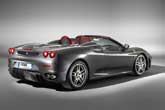
Nuts and Bolts
Nuts and Bolts The Ferrari F430 gets 483 horsepower out of its 4.3-liter V8, enough to propel it to 60 mph in about four seconds and up to a top speed of more than 190 mph. The Ferrari F430 is built around the engine, a relatively small 4.3-liter V8 mounted in the middle of the car right behind the seats. It may lack displacement, but it makes a great deal of horsepower and instills excitement from its first revolution. With 483 horsepower, it propels the F430 Spider from zero to 62 mph in a scant 4.1 seconds on the way to a maximum speed of 193 mph, according to Ferrari. Two transmission types are available. The established six-speed manual with its classic Ferrari-gated shifter and conventional clutch pedal comes standard. Optionally, buyers can select the Formula 1-inspired paddle shifters mounted to the steering column. While the traditional shifter has proven the most popular, the paddle shifters have gained ground in recent years and are becoming more common. This is particularly true as Ferrari engineers refine the system for street driving. Another feature derived from Formula 1 racing is the switch which controls numerous vehicle settings. Select from a somewhat self explanatory menu: Ice, Low Grip, Sport and Race. Each selection dials in specific vehicle settings that help keep the F430 under control in given conditions while allowing the driver to take advantage of the vehicle’s performance capabilities. Ferrari cautions, however, that the Race setting must only be used on the race track or in a controlled setting because it switches off all the F430’s stability and traction control systems. Equally exotic, perhaps, is the optional ceramic braking system that better reins in the F430 from its top speed of nearly 200 mph. When selecting this feature, large Brembo brake calipers, dressed in Ferrari red, clamp down solidly on the cross-drilled and ventilated ceramic discs. While there may be a few naysayers who feel these binders are difficult to operate, I found them to be quite easy to live with. Contrary to popular opinion, there’s no need to get them hot as you might on a racecar and I experienced no fade whatsoever after repeated hard braking from highway speeds. Some may not consider the F430’s E-Diff electronic differential to be a safety item, but Ferrari does. Standard on the F430 Spider, this feature assures maximum grip to the road surface by automatically locking the drive wheels depending on traction requirements. In a vehicle with the F430’s power, the E-Diff insures improved acceleration as well as improved handling. Nearly every auto enthusiast will tell you tires make a great car even better – and so it is with the F430 Spider. Owners have a choice of 225/35ZR19 front and 285/35ZR19 rear tires from either Bridgestone or Pirelli. Both offer exceedingly high grip on the twisty bits yet do not trade ride comfort for handling the way many low profile performance tires do. That rubber is guided by crisp rack-and-pinion steering with excellent on-center feel and precise turn-in, adding to the enjoyment of driving this automobile.
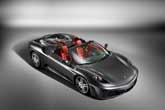
Design
Design A recent incident on a stretch of Pacific Coast Highway involving a rare Enzo has proven how thoroughly Ferrari’s engineers bake occupant protection right into their products. Both versions of the Ferrari F430 have been honed to perfection as designers and engineers worked closely with the Italian automaker’s Formula 1 racing division. Created by Pininfarina in collaboration with Frank Stephenson, both the F430 and F430 Spider are works of art in terms of exterior and interior design. Cutting-edge aluminum technology is incorporated into the body and chassis to give the F430 Spider excellent strength and safety while ensuring extremely highly rigidity levels. The result is a curvaceous shell that flows in arching curves from front to rear, a shell strengthened in the appropriate areas for optimum protection in the event of an accident. Ferrari claims excellent crashworthiness for the F430, and though it’s tough to imagine watching one of these beautiful automobiles being stuffed into a wall on purpose, it seems that a recent incident on a stretch of Pacific Coast Highway in Malibu, Calif., involving one of the company’s rare Enzo supercars has proven how thoroughly Ferrari’s engineers bake protection right into their products. One thing is for sure: even with the F430 Spider’s top lowered there was little cowl shake as I ventured over rough country roads and railroad crossings. The F430’s interior is extremely comfortable. Carefully stitched, supple leather covers most surfaces and the accent trim hints at the racing heritage that has long been a Ferrari legacy. Snug seats hold you and your passenger tight in place through the twisting turns where the F430 shines brightest, and you get the distinct feeling you might be behind the wheel of a formula race car particularly with the controls mounted on the steering wheel. All other ancillary switches and controls are exactly where they should be for easy manipulation. Even at high speeds the Ferrari F430 is surprisingly easy and comfortable to drive.
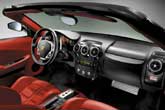
Driving Impressions
Driving Impressions Push the “Start” switch on the steering wheel and the Ferrari F430’s engine roars to life, revving freely and sending my hair follicles snapping to attention once again. Once situated in the bright red Ferrari F430 Spider’s driver’s seat, my adventure begins with the push of the “Start” switch on the steering wheel. The aluminum, 483-horsepower, 4.3-liter V8 roars to life, revving freely and sending my hair follicles snapping to attention once again. My hope is that this strange physiological reaction to the F430 doesn’t continue for much longer, because I’m starting to feel like a continually startled porcupine, but it’s a futile one. The Ferrari F430 sends chills through me on a regular basis. Though the engine only sits just a few inches behind my head, all I hear from the 483 horses is the symphonic exhaust note. Never the ones for modesty, Ferrari designers incorporated a clear engine cover so anyone can gaze upon the artistry of the F430’s mid-mounted engine. A tingle rushes through me as I catch sight of the F430’s trademark red cylinder head covers in the rearview mirror. Enough, already. It’s time to get rolling. The F430’s six-speed manual transmission is a traditional Ferrari setup with a shift lever that moves through a gated pattern set on the center console, but the optional paddle shifters in my test car bring the Formula 1 racer out in everyone. Without getting too technical, the system can be left in “drive” where it acts much like a normal automatic transmission, completing shifts without driver involvement as the engine races toward red line. Push the manual mode switch on the dash and you transfer shifting tasks to the paddles mounted on the steering column. Ah, control of the six-speed gearbox is now at my fingertips. Shifting through the gears took a little practice, but soon I was flicking up and down through the six gears with the skill of a novice racer. One of the paddle shifter’s cool features is its ability to blip the throttle on downshifts, making good drivers better. Under the lightweight, Carrozeria Scagletti-built aluminum body sits a bevy of innovative components that accentuate the F430’s handling and ride. Steering is a precision rack-and-pinion system that takes the slightest inputs from the driver and instantly redirects the car. However, though it’s extremely responsive, the steering does not convey the twitchy uncertainty that is sometimes associated with other sports cars. Both the Bridgestone or Pirelli Z-rated 19-inch tires transfer all the F430’s power and the driver’s inputs to the road, yet this Ferrari’s ride does not punish occupants. Most of the credit for this blend of performance and comfort goes to the self-adjusting suspension system which automatically accounts for variation in road surface, speed and lateral cornering. Of course, in a car that can travel as fast as a Ferrari F430, brakes are an important part of the recipe. During several high-speed stops I found the brakes to be superior to most high-performance sports cars. Needless to say, it is quite comforting to find solid braking in a vehicle that is as quick and agile as this Ferrari. Driving a Ferrari F430 Spider is an experience few will be able to enjoy since the company will make just 1,000 each year for sale in the United States and there is currently a three-year waiting list for them. This demand is understandable, considering the F430 Spider’s fantastic performance and classic Ferrari design. For me, just the thought of standing in the middle of all those prancing horses, their exhausts echoing against the hillside, brings a smile. Whoops! I’m doing that porcupine impression again.
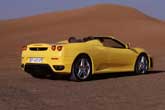
Specifications
Specifications Serial production competitors of the Ferrari F430 include the Aston Martin DB9 Volante, Lamborghini Gallardo Spyder, Mercedes-Benz SL65 AMG, and Porsche 911 Turbo. Test Vehicle: 2006 Ferrari F430 Spider Price of Test Vehicle: $209,222 Engine Size and Type: 4.3-liter V8 Engine Horsepower: 483 horsepower at 8,500 rpm Engine Torque: 343 lb.-ft. at 5,250 rpm Transmission: Six-speed automatic with F1-style paddle shifting Curb weight, lbs.: 3,351 EPA Fuel Economy (city/highway): 11/16 mpg Length: 177.6 inches Width: 75.7 inches Wheelbase: 102.4 inches Height: 48.6 inches Max. Seating Capacity: 2 Max. Cargo Volume: 8.8 cu.-ft. Competitors: Aston Martin DB9 Volante, Lamborghini Gallardo Spyder, Mercedes-Benz SL65 AMG, Porsche 911 Turbo
Photos courtesy of Ferrari
